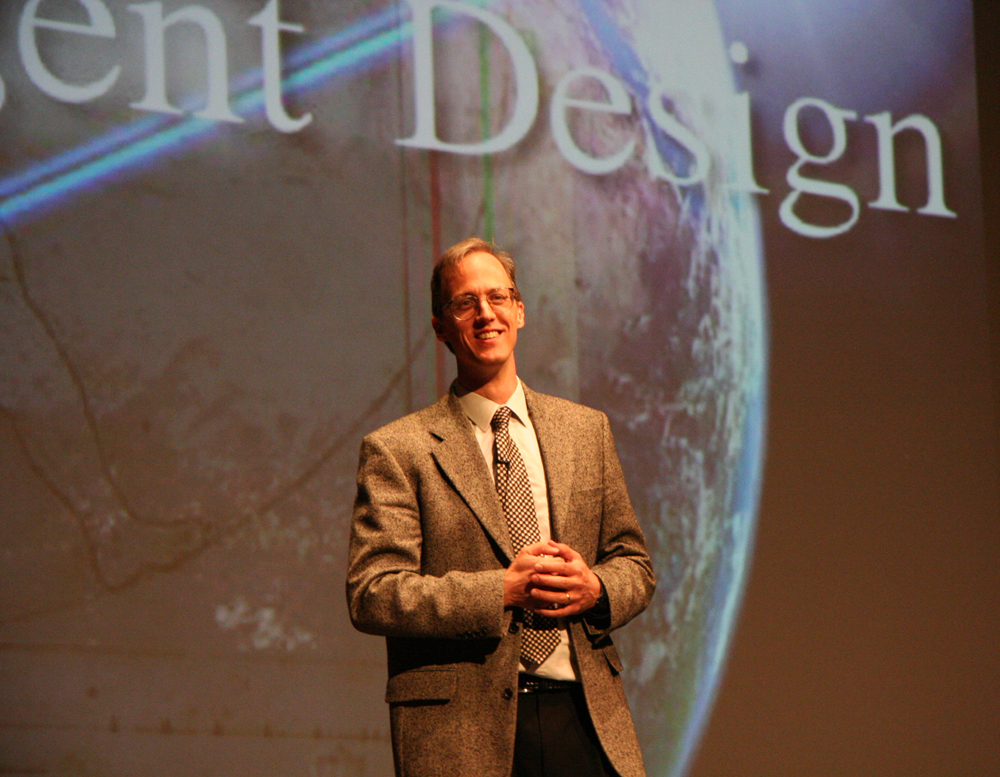
LAWRENCE, Kan. (BP)–Amid the debate in Kansas over a controversial vote by the state’s board of education to allow criticism of evolutionary theory in schools, Intelligent Design proponent William Dembski addressed an audience of 1,500 at the University of Kansas on the “Case for Intelligent Design.”
Dembski, a noted mathematician who is the Carl F.H. Henry Professor of Science and Theology at Southern Baptist Theological Seminary, was sponsored by KU’s Campus Crusade for Christ with support from area churches and Midwestern Baptist Theological Seminary in Kansas City.
Dembski began his presentation by acknowledging the contribution Charles Darwin and his theory have made to the scientific community, while also noting one of the theory’s weaknesses.
“Darwin is a great man. Darwin’s theory is a great idea. His mechanism of random variation and natural selection is a milestone in intellectual history,” Dembski said. “It fundamentally changed our conception of history. And yet it’s not the whole story.”
Although the theory explains many small-scale changes that organisms have undergone over time, Dembski noted that “it has difficulty explaining large-scale changes.”
Darwin, writing in the late 1800s, did not foresee the technological advances in molecular biology of the last 30 years that have allowed scientists to look into the single cell — something Dembski compares to an “automated city” — and see its complex engineering and design.
“Evolutionary theory provides an important window into natural history,” Dembski said, “but it no longer functions as a complete organizational package for biology. It needs to be supplemented.”
Dembski said Intelligent Design — “the study of patterns in nature that are best explained as the result of intelligence” — can provide a more comprehensive framework.
Explaining Intelligent Design, Dembski compared it to building a rocket or baking a cake and commented on the design process that goes into doing both.
“Often we don’t see that whole process taking place,” he said of the design and manufacturing process. “What we’re confronted with is the product at the very end.”
Intelligent Design, he said, asks whether or not a designer can be inferred from that end product.
“Did that product arise as a result of design or is it the result of a purposeless material process?” he said. “Was this the result of intention or accident?”
He said scientists and observers at SETI — which stands for the Search for Extraterrestrial Intelligence and made famous by Hollywood movies like “Contact” in 1997 — do the same thing when discerning radio signals from outer space.
What is seen as perfectly reasonable in many fields, like SETI, has become the cause of great controversy for Intelligent Design, Dembski said, because of the theological implications of the universe having a designer.
“If there is real intelligence behind biology, that would be unevolved [intelligence],” he said. “Then very quickly the G-word [God] comes to the fore.”
The most compelling evidence for Intelligent Design, Dembski noted, is the cell’s “bacterial flagellum” — a bi-directional, motor-driven propeller inside the cell that can spin up to 100,000 r.p.m. and change direction in just a quarter turn.
“In Darwin’s day, the cell was basically a little blob of Jell-O enclosed by a membrane,” Dembski said. “That’s why Darwin didn’t write about the origin of life; he wrote about the origin of species.” The problem was determining how complexity and diversity of life came into being, at a time when most thought single cells were very simple, Dembski said.
“Now you look inside the cell with what we know and you find a world of information processing, storage retrieval, high-tech, high-efficiency, nano-engineered motors,” Dembski said. “You need engineering to understand what’s going on inside the cell.”
There’s little comparison to the complexity of the cell, Dembski noted.
“Name your most complicated human artifact — the supercomputer — it is dwarfed by even the simplest cell.”
Evolution, Dembski said, with its theory of evolving process and slow changes cannot account for the bacterial flagellum’s intricate design.
“What needs to happen if you’re going to tell an evolutionary story is you have to tell a story of gradual change and at each point there has to be some sort of selective advantage,” Dembski said. “The evidence is just not there that these processes can do the sort of design work that I am pointing to.”
The bacterial flagellum — which has become the “icon” of Intelligent Design — has pointed to serious issues within evolutionary theory’s viability, Dembski continued.
“What we’re talking about is a pervasive failure [in evolutionary theory] to account for systems like this,” he said. “These systems have to be explained because this is where nuts and bolts biology takes place.
“If we’re not explaining complexity at the biochemical level, then we have not explained life.”
Addressing frequent criticism that there are theological influences behind Intelligent Design, Dembski noted that the same can be said for evolutionary theory.
“I would put it to you also that there are theological implications to evolution — not that it’s implications for God, but against God.”
Acknowledging that Intelligent Design often gets mixed together with creationism, Dembski pointed out that there are clear distinctions between the two.
“Creationism is always about the source of being of the world — where did everything come from,” he said. “Intelligent Design is content to look at patterns in an existing world and say, ‘Do they point to an intelligence?’ but it doesn’t get you to a source that’s behind everything.”
Just as a carpenter, he said, fashions and cuts wood into furniture, the carpenter is not also responsible for the wood itself.
“That’s what a doctrine of creation does,” he said. “Intelligent Design looks at patterns in nature and [discerns whether there’s] good evidence that there’s intelligence behind it.”
Dembski said he sees Intelligent Design’s theological role more “in a negative sense of clearing out the intellectual rubbish that has been bequeathed on our culture through materialistic, atheistic worldview. But it doesn’t give us a positive theology.
“If you want a positive theology,” he said, “study theology.”
–30–
















